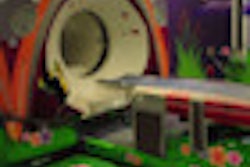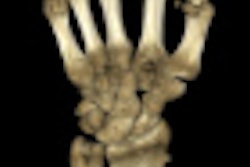Gastroenterology's perspective on virtual colonoscopy isn't entirely positive. But it's improved to the point where gastroenterologists are finding common ground with radiologists on the subject of screening: i.e., that the availability of multiple screening options is the only way to care for an aging U.S. population.
From the view of one leading gastroenterologist, in fact, VC (also known as CT colonography or CTC) does a very good job of caring for older patients. In a new multiyear analysis of virtual colonoscopy at his institutions, gastroenterologist Brooks Cash, MD, chief of medicine at Walter Reed Army Medical Center in Washington, DC, and the National Naval Medical Center in Bethesda, MD, found a low referral rate to conventional colonoscopy after CTC in asymptomatic Medicare-aged individuals, and a low rate of serious extracolonic findings.
In remarks at the International Symposium on Virtual Colonoscopy in Boston on October 25, Cash said that while gastroenterology has traditionally opposed CTC, these days one can at least say that staunch opposition "isn't a universal opinion." Cash has learned how to perform CTC himself as part of his institution's Colon Health Initiative, which embraces both CTC and colonoscopy for screening.
"The Multisociety Task Force has endorsed CTC for average-risk screening; even the [American College of Gastroenterology (ACG)] -- which has been the most vocal opponent of CTC -- in their most recent update said that CTC is a reasonable option when colonoscopy is not feasible," Cash said.
On the other hand, the U.S. Preventive Services Task Force rated CTC "incomplete -- and the [Centers for Medicare and Medicaid Services] denial of coverage issued in 2009 stands, so there's a long way to go," he added.
At its core, gastroenterology's traditional view is that "gastroenterologists see [VC] as a threat -- a threat to their gold standard colonoscopy," he said. Among gastroenterologists there is also a perception of a threat from radiation, which has been "much ballyhooed but not well understood," as well as concerns about the potential overuse of screening, nondetection of diminutive lesions and flat polyps, and extracolonic findings and medicolegal issues, Cash said.
Nevertheless, "I think we can all agree that CTC's validation is complete, and we need to move toward the next step: implementation," he said.
Toward that end, the Colon Health Initiative at the National Naval Medical Center functions as a GI/radiology partnership, he said. Gastroenterologists are the gatekeepers for all colorectal cancer screening, determining the appropriateness of CTC on individual patients, performing the prep, and tracking patient visits, he said. When CTC is determined to be appropriate, radiology takes the lead on performing the exam, and the entire team "understands the importance of offering a same-day, single-prep option" for colon screening, Cash said.
The institution considers CTC appropriate for average-risk patients, as well as those who are at increased risk from colonoscopy or who are unwilling to have a conventional colonoscopy, he said. "We're starting to realize as we survey patients that this is a surprisingly high amount," he said.
And it's considered safe. The Health Physics Society's 2010 statement reiterates that the risk of radiation from low-dose CTC is "extremely low," Cash said.
Perhaps most important in light of colorectal cancer's status as the second leading cause of cancer deaths in the U.S., emerging data show that CTC has the potential to increase screening, Cash said. Among the enrolled population at the Naval Hospital, figures from the Healthcare Effectiveness Data and Information Set (HEDIS) show that when both CTC and colonoscopy are available, colorectal cancer screening compliance rises to nearly 80%, compared to about 70% without the availability of CTC screening, he said.
With the incorporation of CTC at his institution, "we've seen a 10% annual increase in our colonoscopy volumes -- and this contradicts what many gastroenterologists are afraid of -- they're afraid that CTC is going to take their place."
Older patients well-served
Among Medicare-aged patients at the hospitals, Cash and colleagues recently completed a retrospective analysis of CTC exams in individuals 65 years and older between 2004 and 2009.
Excluding symptomatic patients, high-risk patients, and those who come to VC from failed colonoscopy, only 13.8% (188/1,361) of those who underwent CTC were ultimately referred for colonoscopy screening, he reported. In addition:
- Only 3.6% had a nondiagnostic CTC exam
- 82.9% had normal CTC exams
- 13.4% had suspected intracolonic pathology, only 0.7% of which were high-risk (C-RADS C4) findings
- 88% (168/191) of those with C-RADS C2-C4 findings went on to colonoscopy
- Only 8.5% of patients ≥ 65 years had advanced colonic neoplasia
The results in older populations are similar to those in other populations, and similar to results from other researchers, he said.
For example, a 2003 colonoscopy trial known as the Veterans Affairs (VA) Cooperative Study Group 380 (Journal of the American Medical Association, December 10, 2003, Vol. 290:22, pp. 2959-2967) found a prevalence of 11% of advanced colonic neoplasia in the mostly male cohort 50 years and older.
Cash and his team's analysis of Medicare-aged patients also revealed only moderate rates of extracolonic findings, including:
- Likely unimportant (C-RADS E3) findings in 22.5% of patients (317/1,410) that were "most commonly attributable to the cardiac, renal, and pulmonary systems," Cash said
- Classification of known coronary artery calcifications as C-RADS E2 findings reduces E3 prevalence by 50% -- to only 13% of patients
- After known and low-risk findings are eliminated, just 3% of Medicare-aged patients in the analysis had potentially important C-RADS E4 findings at CTC
In addition, colonoscopy is known to be an imperfect gold standard, Cash said. A recent meta-analysis of six tandem colonoscopy studies representing 485 patients found pooled miss rates at colonoscopy of 22% for polyps of any size, 2.1% for polyps 1 mm or larger, 13% of polyps 5-10 mm in diameter, and 26% of polyps 1-5 mm in diameter.
"It's a huge issue right now in our GI societies, and we're really focused on our quality metrics," he said. "CT colonography studies [of colonoscopy miss rates] support similar conclusions."
Fortunately, the emerging evidence shows a very small risk of cancer from missing diminutive polyps. A large study from the endoscopic database found just one colorectal cancer in a diminutive polyp among 3,800 patients in the analysis, he said.
Finally, polyp surveillance is revealing new information on the natural history of polyps, Cash said. In a project under way with Perry Pickhardt, MD, and his team from the University of Wisconsin in Madison, researchers are learning that most surveillance polyps remain stable in size over time.
About 20% of the polyps increase in size, about 24% decrease in size, and "histology may be predictable from the natural history data," he said. Polyps with advanced histology tend to grow, Cash said, while hyperplastic polyps tend to shrink.
"I think we'd all agree that CTC is a proven modality for colon cancer screening, but the GI world still is leery," Cash said. More education is needed, and researchers could use more information about the radiation risk, if possible, though it probably isn't, he said.
"I think we can gain evidence with regard to the potential for increasing colon cancer adherence," Cash said. The evidence is clear that colon cancer detection rates in CTC are equivalent to colonoscopy, and that the prevalence of extracolonic findings is moderate, he said.
By Eric Barnes
AuntMinnie.com staff writer
November 15, 2010
Related Reading
VC advocates tout aggressive strategy for screening coverage, October 26, 2010
Higher colonoscopy complication rates found in seniors, October 19, 2010
Missed cancers common after colonoscopy, October 7, 2010
ACG to Obama: Colonoscopy better than virtual exam, March 4, 2010
VC screening maintains performance in Medicare population, November 9, 2009
Copyright © 2010 AuntMinnie.com



















